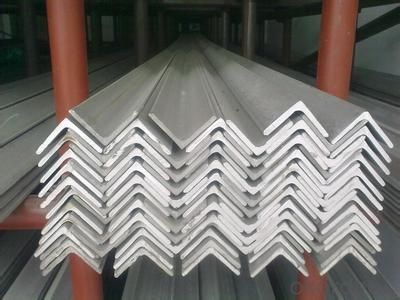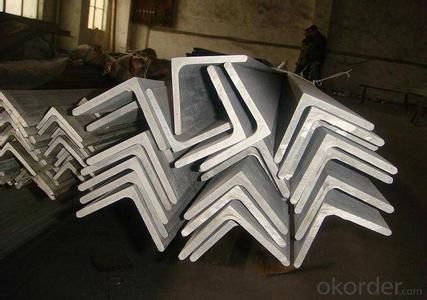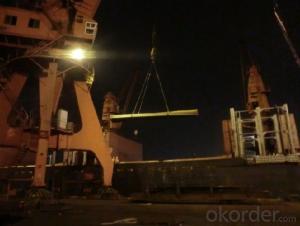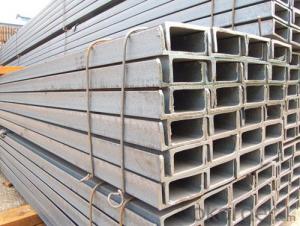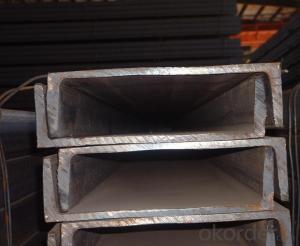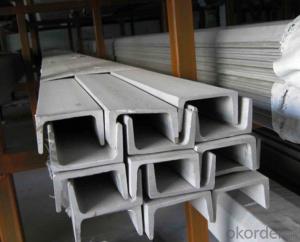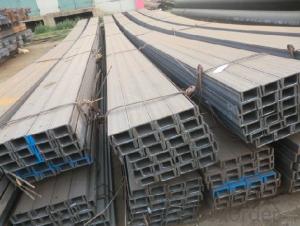Steel JIS U Channel Or UPN Or GB U Channel
- Loading Port:
- Tianjin
- Payment Terms:
- TT OR LC
- Min Order Qty:
- 25 m.t.
- Supply Capability:
- 20000000 m.t./month
OKorder Service Pledge
OKorder Financial Service
You Might Also Like
Specification
Product Description:
OKorder is offering high quality Hot Rolled Steel I-Beams at great prices with worldwide shipping. Our supplier is a world-class manufacturer of steel, with our products utilized the world over. OKorder annually supplies products to European, North American and Asian markets. We provide quotations within 24 hours of receiving an inquiry and guarantee competitive prices.
Product Applications:
According to the needs of different structures, Angle can compose to different force support component, and also can be the connections between components. It is widely used in various building structures and engineering structures such as roof beams, bridges, transmission towers, hoisting machinery and transport machinery, ships, industrial furnaces, reaction tower, container frame and warehouse etc
Product Advantages:
OKorder's Steel I-Beams are durable, strong, and resist corrosion.
Main Product Features:
· Premium quality
· Prompt delivery & seaworthy packing (30 days after receiving deposit)
· Corrosion resistance
· Can be recycled and reused
· Mill test certification
· Professional Service
· Competitive pricing
Product Specifications:
Manufacture: Hot rolled
Grade: Q195 – 235
Certificates: ISO, SGS, BV, CIQ
Length: 6m – 12m, as per customer request
Packaging: Export packing, nude packing, bundled
Sizes: 25mm-250mm | ||||||||||||
a*t | ||||||||||||
25*2.5-4.0 | 70*6.0-9.0 | 130*9.0-15 | ||||||||||
30*2.5-6.6 | 75*6.0-9.0 | 140*10-14 | ||||||||||
36*3.0-5.0 | 80*5.0-10 | 150*10-20 | ||||||||||
38*2.3-6.0 | 90*7.0-10 | 160*10-16 | ||||||||||
40*3.0-5.0 | 100*6.0-12 | 175*12-15 | ||||||||||
45*4.0-6.0 | 110*8.0-10 | 180*12-18 | ||||||||||
50*4.0-6.0 | 120*6.0-15 | 200*14-25 | ||||||||||
60*4.0-8.0 | 125*8.0-14 | 250*25 | ||||||||||
FAQ:
Q1: Why buy Materials & Equipment from OKorder.com?
A1: All products offered byOKorder.com are carefully selected from China's most reliable manufacturing enterprises. Through its ISO certifications, OKorder.com adheres to the highest standards and a commitment to supply chain safety and customer satisfaction.
Q2: How do we guarantee the quality of our products?
A2: We have established an advanced quality management system which conducts strict quality tests at every step, from raw materials to the final product. At the same time, we provide extensive follow-up service assurances as required.
Q3: How soon can we receive the product after purchase?
A3: Within three days of placing an order, we will begin production. The specific shipping date is dependent upon international and government factors, but is typically 7 to 10 workdays.
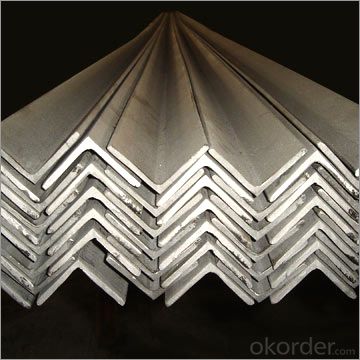

- Q: How do steel channels perform in high-temperature environments?
- Steel channels typically perform well in high-temperature environments due to their inherent strength and durability. The properties of steel, such as its high melting point and resistance to thermal expansion, make it suitable for use in elevated temperatures. Steel channels can withstand high temperatures without significant deformation or loss of structural integrity. One of the main reasons steel channels are effective in high-temperature environments is their ability to retain their mechanical properties at elevated temperatures. Steel has a high thermal conductivity, which allows it to effectively dissipate heat and prevent excessive temperature rise. This property helps to maintain the structural stability of steel channels even when exposed to high heat. Moreover, steel channels are often designed to have a high fire resistance rating. This is achieved by incorporating fire-resistant coatings or fireproofing materials to enhance their performance in extreme temperatures. These measures help to protect the steel channels from the detrimental effects of heat, including weakening or deformation. It is important to note that the performance of steel channels in high-temperature environments can be influenced by factors such as the specific grade of steel used and the duration of exposure to elevated temperatures. Different grades of steel have varying thermal properties, so it is crucial to select the appropriate grade based on the specific temperature requirements of the application. In summary, steel channels generally perform well in high-temperature environments. Their strength, durability, and ability to retain mechanical properties make them suitable for use in such conditions. However, it is recommended to consult with experts or refer to the manufacturer's specifications to ensure the steel channels are selected and utilized correctly for optimal performance in high-temperature environments.
- Q: Can steel channels be used for machinery framing?
- Indeed, machinery framing can make use of steel channels. Given their robustness and resilience, steel channels are frequently employed across the construction and manufacturing sectors. They furnish a sturdy and inflexible framework capable of sustaining heavy machinery and equipment. Thanks to their exceptional structural support, steel channels prove themselves ideal for machinery framing purposes. Moreover, they can be effortlessly personalized and manufactured to satisfy precise design needs, guaranteeing an exact fit and optimal performance for machinery framing endeavors.
- Q: What are the different methods of painting steel channels?
- There are several methods of painting steel channels, including spray painting, brush painting, and electrostatic painting. Spray painting is a common method that involves using a spray gun to evenly coat the surface of the steel channel with paint. Brush painting involves manually applying paint with a brush, which allows for more control and precision in smaller areas. Electrostatic painting is a technique where the paint is positively charged and the steel channel is grounded, resulting in a highly efficient and even coat of paint.
- Q: Can steel channels be used in the telecommunications parts manufacturing industry?
- Yes, steel channels can be used in the telecommunications parts manufacturing industry. Steel channels are commonly used in various industries due to their strength, durability, and versatility. In the telecommunications industry, steel channels can be used to support and protect cables, provide structural support in equipment racks, or as mounting brackets for various components. They offer excellent load-bearing capabilities and can withstand harsh environmental conditions, making them suitable for telecommunications parts manufacturing.
- Q: What is the purpose of steel channels?
- The purpose of steel channels is to provide structural support and reinforcement in various construction and manufacturing applications. They help distribute the load evenly and add strength to structures such as buildings, bridges, and machinery. Steel channels also serve as framing elements, allowing for the connection of different components and facilitating the construction process.
- Q: What are the advantages of using steel channels over other materials?
- Using steel channels instead of other materials offers several advantages: 1. High strength and durability: Steel channels are renowned for their ability to bear heavy loads and provide structural stability. This makes them suitable for a wide range of construction and engineering applications. 2. Versatility: Steel channels can be easily shaped and manipulated to meet specific requirements. Whether they need to be cut, welded, or bent, they offer flexibility in design and construction projects. 3. Cost-effective: Compared to materials like aluminum or wood, steel channels are a cost-effective choice. They require minimal maintenance, have a longer lifespan, and can be recycled, resulting in reduced overall construction and maintenance costs. 4. Fire-resistant: Steel channels inherently possess fire resistance properties, making them a safer option for building structures. They do not contribute to the spread of fire and allow for more time during emergencies for people to evacuate. 5. Sustainability: Steel is highly sustainable as it can be recycled endlessly without losing its properties. Opting for steel channels promotes environmental conservation and reduces the carbon footprint associated with construction projects. 6. Corrosion resistance: Steel channels can be treated with coatings or galvanized to enhance their resistance to corrosion. This makes them suitable for outdoor applications where they may come into contact with moisture, humidity, or other corrosive elements. 7. Structural integrity: Steel channels provide excellent structural integrity, ensuring that the components they support remain stable and secure. This is especially important in applications where safety and load-bearing capacity are crucial, such as bridges, high-rise buildings, or industrial structures. In conclusion, the use of steel channels offers numerous advantages including strength, durability, versatility, cost-effectiveness, fire resistance, sustainability, resistance to corrosion, and maintenance of structural integrity. These benefits make steel channels the preferred choice for various construction and engineering projects.
- Q: How do steel channels contribute to thermal insulation?
- Steel channels do not contribute to thermal insulation on their own. Steel channels are typically used as structural components in construction, such as in the framing of walls or ceilings. However, in the context of thermal insulation, steel channels can be used as part of a system to enhance the overall insulation performance. Steel channels can be incorporated into thermal insulation systems by creating a framework or support structure for insulating materials, such as foam boards or mineral wool. These insulating materials are then placed within the steel channels, creating a barrier that helps to reduce heat transfer. By providing a stable and secure framework, steel channels help to ensure that the insulation materials are properly installed and remain in place. This eliminates gaps or air pockets that can compromise the effectiveness of the insulation. Additionally, steel channels can be used to create air cavities or air gaps within the insulation system. These air pockets can act as additional barriers to heat transfer, as air is a poor conductor of heat. By reducing the direct contact between the interior and exterior surfaces, the steel channels contribute to the overall thermal insulation of the structure. It is important to note that while steel channels can play a role in thermal insulation, they alone are not sufficient to provide effective insulation. They need to be used in combination with appropriate insulating materials and other insulation techniques, such as sealing gaps and using reflective surfaces, to achieve optimal thermal insulation performance.
- Q: Are steel channels suitable for the mining manufacturing industry?
- Steel channels are an ideal choice for the mining manufacturing industry. They are widely used in various industries, including mining, because of their exceptional strength and durability. In the mining industry, where rugged conditions and intensive use are common, heavy-duty equipment and machinery are required. Steel channels, being made of a strong and sturdy material, can provide the necessary support and structural integrity to withstand the demanding requirements of the mining manufacturing industry. Furthermore, steel channels offer flexibility in terms of design and configuration, making them suitable for a wide range of applications within the mining industry. They can be used to construct frameworks, support structures, conveyor systems, and other equipment essential for mining operations. Moreover, steel channels have a high load-bearing capacity, which is crucial in the mining industry where heavy loads and vibrations are prevalent. They can efficiently distribute weight and handle stress, ensuring the safety and dependability of mining equipment and structures. Additionally, steel channels are resistant to corrosion, making them well-suited for use in the mining industry where exposure to moisture, chemicals, and other corrosive substances is common. This corrosion resistance extends the lifespan of the equipment, reducing maintenance and replacement costs. In conclusion, steel channels are an excellent choice for the mining manufacturing industry due to their strength, durability, versatility, and resistance to corrosion. They provide the necessary support and structural integrity needed for heavy-duty mining equipment and structures, making them a reliable option for various applications within the industry.
- Q: What does channel C10 mean? What is the full name of C?
- Type C steel is actually a thin walled channel steel. 10 said its height is 100mm, it is also the type.
- Q: What are the load distribution factors for steel channel beams?
- The load distribution factors for steel channel beams are influenced by several factors, including the beam's size, shape, and overall structural design, as well as the type of load being applied. These factors assist in determining how the load is spread across the beam and its supporting structures. Steel channel beams generally possess favorable load distribution characteristics due to their shape and structural properties. The beam's flanges and web contribute to its stability and enhance its load distribution abilities. Various elements, such as the span length, load type and magnitude, and support conditions at both ends of the beam, play a critical role in establishing the load distribution factors. For instance, shorter span lengths usually result in a more even load distribution, while longer spans may necessitate additional supports or reinforcements to ensure proper distribution. The load distribution factors are also affected by the type of load being applied, whether it is a concentrated load or a distributed load. Concentrated loads, like those exerted by machinery or equipment, require careful consideration to ensure even distribution across the beam and prevent localized stress concentrations. Furthermore, the load distribution factors are influenced by the design of the supporting structures, such as columns or walls. Well-designed connections between the beam and its supports facilitate efficient load transfer and uniform distribution throughout the structure. To determine the specific load distribution factors for a particular steel channel beam, it is important to consult with structural engineers or refer to design codes and standards. These factors may vary depending on the application and design requirements, and adherence to industry standards is crucial to ensure safe and efficient load distribution during the beam's design and installation process.
Send your message to us
Steel JIS U Channel Or UPN Or GB U Channel
- Loading Port:
- Tianjin
- Payment Terms:
- TT OR LC
- Min Order Qty:
- 25 m.t.
- Supply Capability:
- 20000000 m.t./month
OKorder Service Pledge
OKorder Financial Service
Similar products
Hot products
Hot Searches
Related keywords



